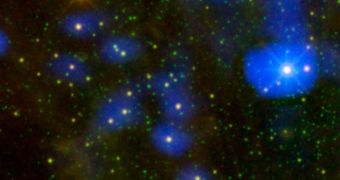Astronomers say that one of the stars they discovered during a 2010 survey of the night sky is currently spraying large amounts of dust into its surrounding area. We may be witnessing the process through which stars seed the Universe with the building blocks of other stars, planets or life.
It is well known that hydrogen and helium were the only chemicals in the Universe following the Big Bang. Experts have determined in past investigations that heavier elements were produced by nuclear fusion at the core of the first massive stars.
When these objects reached the end of their burning cycle, they exploded as supernovae, spreading the material in their stellar nurseries, and enriching the hydrogen gas with other chemicals. This cycle was then repeated many times over, eventually enabling the emergence of so-called high-metallicity stars.
These are stellar objects that feature relatively high concentrations of chemicals heavier than hydrogen and helium, such as carbon, oxygen and silicon. Planets are more likely to develop around these stars.
What the research team found in a survey conducted by the NASA Wide-field Infrared Survey Explorer (WISE) is a star that is currently spewing out vast volumes of dust from its surface. The object is about to reach the end of its burning cycle.
Dubbed WISE J180956.27-330500.2, the star is now 100 times brighter than in the images collected just two decades ago. “We were not searching specifically for this phenomenon, but because WISE scanned the whole sky, we can find such unique objects,” researcher Poshak Gandhi explains.
The expert is the lead author of a new paper detailing the findings, which will appear in an upcoming issue of the esteemed Astrophysical Journal Letters. He is based at the Japan Aerospace Exploration Agency (JAXA).
During the latest explosion, the star released around one Earth mass of dust, which it then promptly proceeded to heat to extreme temperatures. In turn, this caused the material to release vast amounts of infrared light, which explains why WISE perceived it as being so bright.
“Observing this period of explosive change while it is actually ongoing is very rare,” explains paper coauthor Issei Yamamura, also from JAXA.
“These dust eruptions probably occur only once every 10,000 years in the lives of old stars, and they are thought to last less than a few hundred years each time. It's the blink of an eye in cosmological terms,” the expert adds.
“It's an intriguing glimpse into the cosmic recycling program. Evolved stars, which this one appears to be, contribute about 50 percent of the particles that make up humans,” comments NASA Headquarters WISE program scientist, Bill Danchi, who was not a part of the research team.

 14 DAY TRIAL //
14 DAY TRIAL //